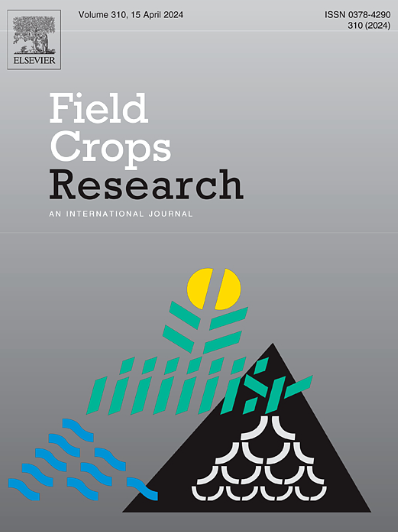Adjusted CBA-Wheat model for predicting aboveground biomass in winter wheat from hyperspectral data
IF 5.6
1区 农林科学
Q1 AGRONOMY
引用次数: 0
Abstract
Context or problem
Crop aboveground biomass (AGB) is a key indicator of photosynthesis and carbon cycle dynamics in agricultural ecosystems. The availability of accurate, real-time AGB data enables efficient resource management and precision farming. The crop biomass algorithm for wheat (CBA-Wheat) estimates winter wheat AGB using vegetation index (VI) and Zadoks stage (ZS), but acquiring ZS data through field surveys is challenging for large-scale applications.
Objective or research question
This study aimed to optimize the CBA-Wheat model by incorporating the concept of the relative day of the year (RDOY) as a replacement for ZS and combining it with VI to enhance the performance of the wheat growth model.
Methods
We proposed the concept of RDOY to replace the traditional ZS, thereby optimizing the CBA-Wheat model. The study used data from Xiaotangshan, Beijing, from 2013 to 2020 for model development. The validation dataset included 2021 Xiaotangshan data, 2010 suburban Beijing data, and 2012 Yucheng, Shandong data for testing the model’s temporal and spatial transferability. Additionally, we compared the performance of the CBA-WheatRDOY model with machine learning models, including Partial Least Squares Regression (PLSR) and Random Forest (RF).
Results
We found that the modified CBA-WheatRDOY model, utilizing the modified simple ratio vegetation index (MSR) as an input parameter, achieved the highest AGB estimation accuracy, with a coefficient of determination (R²) of 0.82 and a root mean square error (RMSE) of 1.71 t/ha. This result surpassed the performance of partial least squares regression (R² = 0.78, RMSE = 1.48 t/ha) and random forest (R² = 0.73, RMSE = 2.03 t/ha) models when RDOY was introduced.
Conclusions
Our findings highlight the effectiveness of introducing RDOY in improving the accuracy of winter wheat biomass estimation within the CBA-Wheat model. Moreover, RDOY is a superior alternative to traditional phenological observations and can potentially enhance the performance of conventional machine learning models.
Implications or significance
Compared with existing algorithms, the CBA-WheatRDOY model, grounded in RDOY, not only responds sensitively to various phenological stages but also exhibits improved inversion accuracy. This approach holds promising potential for enhancing the timeliness and spatial extrapolation of winter wheat AGB predictions, advancing precision agriculture and ecosystem management.
利用高光谱数据预测冬小麦地上生物量的调整CBA-Wheat模型
作物地上生物量(AGB)是反映农业生态系统光合作用和碳循环动态的重要指标。准确、实时的AGB数据的可用性使有效的资源管理和精准农业成为可能。小麦作物生物量算法(CBA-Wheat)利用植被指数(VI)和Zadoks阶段(ZS)估算冬小麦AGB,但通过野外调查获取ZS数据对于大规模应用具有挑战性。本研究旨在通过引入相对日(RDOY)概念替代ZS,并与VI相结合,优化CBA-Wheat模型,以提高小麦生长模型的性能。方法提出RDOY的概念来取代传统的ZS,从而对CBA-Wheat模型进行优化。该研究使用了北京小汤山2013年至2020年的数据进行模型开发。验证数据包括2021年小汤山数据、2010年北京郊区数据和2012年山东禹城数据,以检验模型的时空可移植性。此外,我们将CBA-WheatRDOY模型与机器学习模型(包括偏最小二乘回归(PLSR)和随机森林(RF))的性能进行了比较。结果以改良的简单植被指数(MSR)为输入参数的CBA-WheatRDOY模型的AGB估计精度最高,决定系数(R²)为0.82,均方根误差(RMSE)为1.71 t/ha。该结果优于引入RDOY的偏最小二乘回归模型(R²= 0.78,RMSE = 1.48 t/ha)和随机森林模型(R²= 0.73,RMSE = 2.03 t/ha)。结论在CBA-Wheat模型中引入RDOY可提高冬小麦生物量估算的准确性。此外,RDOY是传统物候观测的一种更好的替代方法,可以潜在地提高传统机器学习模型的性能。与现有算法相比,基于RDOY的CBA-WheatRDOY模型不仅对不同物候阶段的响应敏感,而且反演精度也有所提高。该方法在提高冬小麦AGB预测的时效性和空间外推性,推进精准农业和生态系统管理方面具有广阔的应用前景。
本文章由计算机程序翻译,如有差异,请以英文原文为准。
求助全文
约1分钟内获得全文
求助全文
来源期刊

Field Crops Research
农林科学-农艺学
CiteScore
9.60
自引率
12.10%
发文量
307
审稿时长
46 days
期刊介绍:
Field Crops Research is an international journal publishing scientific articles on:
√ experimental and modelling research at field, farm and landscape levels
on temperate and tropical crops and cropping systems,
with a focus on crop ecology and physiology, agronomy, and plant genetics and breeding.
 求助内容:
求助内容: 应助结果提醒方式:
应助结果提醒方式:


